Michael Pronko's Blog, page 10
March 28, 2018
Global Award Best from Asia

Global Award Best from Asia
Reader Views
March 21, 2018
Season of Shame
The cherry blossom spring of Japan is stunning. In early March, the blossoms start in the far south of the country, then gradually work northward, layering the country in pink and white. After slipping into the blossom-viewing dream, it’s hard to even notice the accompanying flurry of pollen allergies, school commencements and first jobs. It always feels like the country could hardly restart, as it does in April, without the backdrop of cherry blossoms.
But that’s late spring. Early spring, really, late-winter February and grey March, is the season of shame.
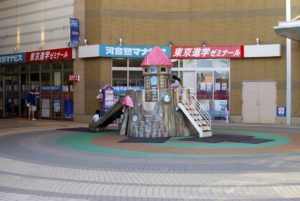 Just waiting…playhouse outside cram schools.
Just waiting…playhouse outside cram schools.Even those far removed from the rite of passage know what’s happening. At the beginning of February, everyone in Tokyo moves with an odd mix of respect, patience and long-held memories. The focus of their tension is the entrance exam season, which precedes cherry blossom season by upping the social pressure that hanami helps subdue.
Every year, I see students snuffling back colds over a study book on the train, their body language not far from the fetal position. They stop being kids and devote their minds and bodies to being tested. It’s not so different from tribal communities where the coming-of-age ritual involved fending for oneself alone in the desert or forest as a passage to adulthood.
Only, in Japan, it’s a journey into test prep books, over-lighted study rooms, and drilling from specialized teachers—spaces devoid of the richness of natural experience that a desert or forest might bestow. Tangling with mostly meaningless, inert information, the exam is less about education than about undergoing the cultural rituals that position them in the social hierarchy.
When the exams are finished, grading starts. Answer papers are secreted into university safes. Specialized security companies rush the answers in unmarked trucks to grading centers where computers whirl away on multiple choice answers. Professors huddle in claustrophobic rooms all over the country, grading essay questions one by one. University office workers put aside their other duties to assist with administrating, proctoring, organizing and ranking the scores. Reams of statistics are calculated to decide students’ fates. Parents and teachers wait anxiously, test-takers more anxiously.
And the result? Some pass, some do not. It’s in—or out, accepted or rejected, celebration or depression, exultation or shame.
Many parents consider the year the worst of their lives. Friends of mine with kids in exam years do not go out to enjoy themselves during the jukensei test-taking year. They focus on supporting their kids. A few parents at the swimming pool where I go tell me they sneak out to exercise to try to calm the year-long panic. Then they hurry home to prepare meals, organize schedules and establish a supportive home atmosphere. There are books about how parents should help.
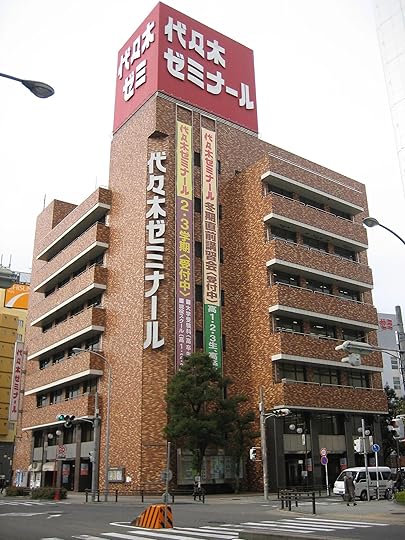 Crammed in–shrine to testing
Crammed in–shrine to testing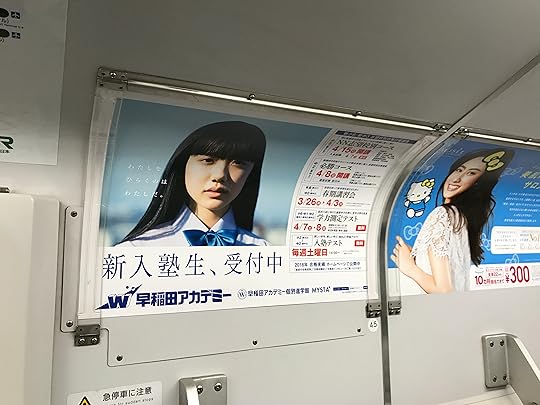 Looking to the future, on the left, just looking good, on the right
Looking to the future, on the left, just looking good, on the rightWhen strangers in Tokyo ask where I work, they will often recount—uninvited—their own tale of that prepping year. I listen to them confessing they were never good at tests or humbly restating how lucky they were. No one ever really knows why they were accepted or rejected—there’s no rank or score or feedback—but it’s an experience that overshadows their lives.
Japan is often said to be a shame culture, as opposed to a guilt culture, and while that is surely a simplification of a vast complexity of emotions, it always strikes me as somewhat true this time of year. The fear of shame motivates and the memory of shame never disappears. It’s the shame, the memory of it or the need to avoid it, that keep exam season sharp in the national mind and mood.
What happens to those that fail? It’s often not that bad. Most students take several exams, which means they will get in to a school that is ranked lower than the one they really wanted to go to. That “just-missed” feeling, though, often wounds almost as much as failing. At the end of dinners with my seminar students, they will often confess their first or second choices. I can see them wondering about the other life not lived, missed by perhaps just a few points, one answer, or two.
Those that fail can take a year off to try again. Being able to call oneself a ronin, or masterless samurai, helps counter the blow to one’s pride by calling forth traditional strengths. Ronin were masterless, but they kept their swords and fought for important causes, at least in the movies, where they are portrayed with respect for their courage to go it alone following the code.
I feel a bit of shame myself when I see exam cram school ads spring up after the results are announced. It seems a cruel reminder, and an omnipresent one. There is hardly a train or bus or billboard in Tokyo without such ads, complete with success stories and monthly fees. It’s in the air, just like, later on, cherry blossoms.
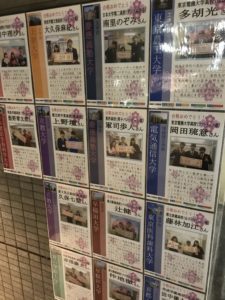 And the winners are…list of students passing in front of cram school. Congratulations!
And the winners are…list of students passing in front of cram school. Congratulations!Often, the faces on these advertisements are young girls with perfectly combed hair in prim school uniforms. Their eyes overflow with clear-eyed gaman, that peculiar Japanese word for endurance/patience/stamina. They look to the horizon, unafraid, determined, and with the right tuition money, supported by a network of cram schools, teachers and practice techniques. It’s a portrait of melodramatic struggle. And like in all melodrama, some win, some lose, fairly or unfairly.
But even the attractive models in the advertisements must pass through exam season. They are no different than every other Japanese who has had the arc of their life’s pendulum set during the few focused hours of the exams either too far to the side of shame—or too far towards pride. Beneath the poses, their faces also reveal the tension that comes from trying to avoid the greatest potential shame of their lives—failing the entrance exam.
I cringe at all these cram school ads springing up like perennial reminders of the clandestine power of testing to let flower, or stymie, entire lives. And every year, I wonder how many Tokyoites around me are recalling their own exam day, reflecting on whatever the results were for them, before the waves of cherry blossoms in late March and early April help loosen that memory to float away and land where it will.
(March 20, 2018)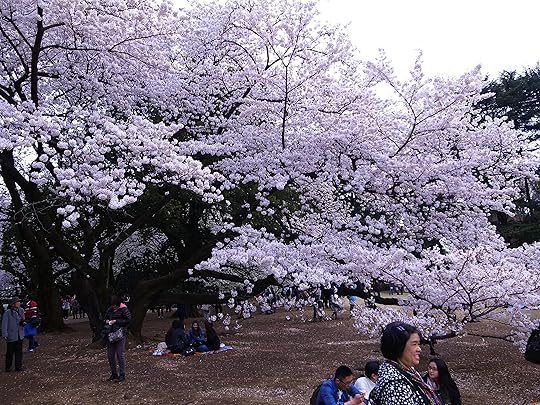
February 14, 2018
February 2, 2018
Feathered Quill Book Award
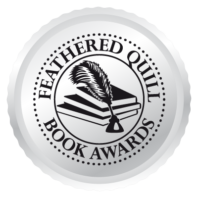
Feathered Quill Book Award
Silver Award – Mystery
December 23, 2017
Book Review from What Cathy Read Next
Book Review: The Last Train by Michael Pronko
Posted on December 15, 2017 by What Cathy Read Next
https://whatcathyreadnext.wordpress.com/
My Review
When I interviewed Michael on my blog last year (click here to read the full interview), he described The Last Train as ‘more whydunit than whodunit’ and having now read the book I can certainly understood why he said that. Much of the excitement of the book comes from following detective Hiroshi Shimizu in his attempts to identify and track down the mysterious woman who committed the murder. The trail leads Hiroshi from the flashy malls and smart high-rise buildings to the decidedly seedier world of hostess clubs and bars. As the author explains, “…in the novel, I wanted to look beneath the surface. The giant skyscrapers and constant construction are amazing, but there’s a lot going on behind the go-go big-city bright-lights, and a lot of it not so good.”
As the investigation progresses, Hiroshi begins to understand the threat he faces from vested interests who may be involved in the shady dealings he starts to uncover. He also starts to realise just what a clever and ruthless opponent he is up against and to get an inkling of the motivation that drives her. When the full facts are revealed you may find yourself questioning where true justice lies.
What really sets The Last Train apart from other run-of-the-mill crime thrillers for me was its Tokyo setting. I loved learning all about Japanese culture and customs. Take this scene in which Hiroshi and his boss, Takamatsu, drink sake together in the traditional manner.
‘The master pulled back a brown curtain over a glass-sided refrigerator filled with sake bottles. He pulled out two small chilled glasses from the top shelf and set these on the upper counter inside small, square, cedar wood boxes. The master shuffled the dozen or so bottles inside the fridge until he found the ones he wanted. Carrying these to the counter, he hoisted the large bottle of cold sake and, cradling it in the crook of his arm, poured out the clear, clean liquid. The sake flowed gently over the top of the lip of the glass into the box, arousing the aroma of cedar and fresh rice. He poured out sake from a different bottle for Hiroshi and placed both bottles on the counter so that each displayed the artful calligraphy of their labels.
They bowed down like penitents to take the first sip without spilling. Then they plucked up the small, thumb-sized glasses for a silent toast before downing the second gulp. Finally, they poured the spill-over from the cedar box into the glass, took another sip, and set their half-full glasses back inside the wet cedar boxes.’
The book cleverly brings to life the intriguing juxtaposition of ancient and modern that exists in Japan. So you have temples and prayer rituals, the elaborate customs for greeting and for drinking tea. But at the same time you have the modern malls full of shops selling up-to-the-minute designer goods and the latest technology, and the packed subways and neon-lit sidewalks of Roppongi.
‘People streamed out of subway exits, slid out of taxis, and stepped off bus after bus. Hordes of office workers in dull gray pants and dark skirts blocked corners, shouting directions into their cell phones to those yet to arrive. Fashion-conscious hipsters, mini-skirted amateurs, and yakuza wannabes walked to their favourite places to play, eat, drink, or work.’
The work culture with its emphasis on drinking with colleagues after work, to my eyes at least, seems particularly alien and the position of women quite regressive with real antipathy in some quarters towards women whose behaviour is considered ‘un-Japanese’.
I really enjoyed The Last Train for both its compelling storyline and its use of Tokyo as a location. Luckily for me – and I suspect, other readers – the author is working on two further books in the series: Japan Hand, which explores the relationship between Japan and the American military bases; and Thai Girl in Tokyo, which has two great female characters navigating the dangers of Shibuya’s underground nightlife. Both books are due for publication in 2018.
In three words: Atmospheric, compelling, mystery
Follow my blog with Bloglovin
https://whatcathyreadnext.wordpress.com/2017/05/31/the-last-train-by-michael-pronko/
November 22, 2017
Winner 2017 Crime Fiction
Beverly Hills Book Award
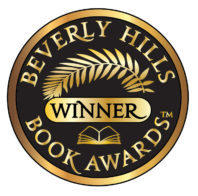
Winner 2017 Crime Fiction
Beverly Hills Book Award
November 20, 2017
Book Excellence Awards

2017 Winner Mystery
Book Excellence Awards
Book Excelence Awards

2017 Winner Mystery
Book Excellence Awards
In Reference to Murder
August 08, 2017
Author R&R with Michael Pronko
Michael Pronko has won numerous awards for his three collections of writings about life in Tokyo. He has written about Japanese culture, art, jazz, society, architecture, and politics for Newsweek Japan, The Japan Times, Artscape Japan, as well as other venues. He has appeared on NHK and Nippon Television and runs his own website, Jazz in Japan. He teaches American Literature and Culture at Meiji Gakuin University in Tokyo and after class wanders Tokyo contemplating its intensity.
His most recent novel is The Last Train, a mystery-thriller set in Tokyo. (The second in the series, Japan Hand, will be out in February 2018.) When The Last Train opens, Hiroshi Shimizu is perfectly settled into his life investigating white-collar crime in Tokyo. But after an American businessman turns up dead, Hiroshi’s mentor Takamatsu drags him out to the notorious and intriguing hostess clubs and futuristic skyscraper offices of Tokyo in search of a possible killer. When Takamatsu goes missing, Hiroshi teams up with ex-sumo wrestler Sakaguchi as they scour Tokyo’s sacred temples, corporate offices, and industrial wastelands to find out where Takamatsu went and why an average-seeming woman could have been driven to murder. The novel takes an intense look at the nuances of Japanese interpersonal relationships and the power dynamics of gender roles and how women—and men, too—are treated in this ancient society.
Michael stops by In Reference to Murder today to discuss the book and how he goes about researching:
As a writer, I don’t, thankfully, suffer from writer’s block, but I do sometimes suffer from research blockade. That’s the moment where I have to stop to find out what I need to know before I can go forward. That’s not a bad thing, but a natural and necessary part of creating a narrative. Writing my first Hiroshi detective novel, The Last Train, research blockade often put a hold on production to focus on content.
Even though I’ve lived in Tokyo for twenty years, it was sometimes impossible to produce clear, strong sentences (i.e. a “form”) without knowing certain cultural and non-cultural details (i.e. “content”). For example, I can’t elegantly and succinctly describe what a machine lathe looks like without looking at one. I can’t describe a night in a net café without knowing the cost, and I can’t put in a fatal wound without looking at images of a sword cut. I think of research as finding the right content to fill out and improve the form.
It would be nice if all research could be done ahead of time, but it rarely works like that for me. Working on Japan Hand, the second in the Hiroshi series, I first read extensively about America’s military bases in Japan and the history of Japan and America’s military alliance. But, that was not enough. Small details still needed to be checked and added while writing. I can’t just load up the research cart and let it flow. It’s a back and forth process.
Ongoing research, as I think of it, is not just information about history, dates, or facts, though. It involves much more. To me, in addition to the background textual and informational input, research involves different kinds of content: experience, sensory details, specialized and arcane knowledge, and a lot of self-examination. All these are necessary to produce a good, solid base of research upon which to build prose with energy and clarity and believability.
Experiential research
I love to stand and look and feel places. Since Tokyoites rarely do that, I often look a bit foolish, but that’s OK. It takes time to sink in. Other experiences can be difficult and expensive. An evening at a hostess club can set you back a week’s salary. But to not experience firsthand what it’s like to have beautiful women pouring your drinks and making small talk is to not have done the research. (And for the record, it’s very weird.) For other experiences, like ramen noodle restaurants, I like to sit at the counter slurping and imagining the novel’s characters there. All that ‘research’ soaks into your unconscious and influences the writing of scene, setting, character, and conflict. Other experiential research can be pure chance. I came across the cleaning up of a train suicide twenty years ago. That experience stayed with me and became part of the novel.
Sensory research
This is similar to experiential, but more focused. I often take photos of places I’ll use in my novels. I also search for photos of specific things online. Sensory details put readers in a place and make them feel it more deeply. The smell of a canal, the texture of a rusted staircase, the taste of sake—if I see an image of it, I can more easily conjure it in words. The real world is a hard thing to describe, but sensory input can make a scene come alive, or in the case of a murder scene, become dead. Looking online for photographs or images of places or objects often spurs my sensory memory. That may not seem like research in the traditional sense, but sensory impressions can be as powerful as historical facts.
Specialized research
For my novel Japan Hand, the killer uses a short sword. So, I wanted to experience a sword in person, which was terrifying. I also did a lot of traditional research, like reading the history of swords in Japan, and texts of swordsmen like Takuan Soho and Miyamoto Musashi. But that potentially passive history of swords and theory of swordsmanship was activated by experiencing swords up close. I also ask people who know. One of my friends who studied aikido for decades dropped me to the tatami when I asked him how you flip someone. He just twisted my arm—somehow—and I was down. And yes, it hurt. But, it made it clear how powerful martial arts are. Reading about it or watching a YouTube video doesn’t cause any pain.
Internal research
Inside everyone is a library of emotions, confusions, memories and reactive tendencies. Tapping into that internal catalogue helps to ground the story in an internal world as well as an external world. That can be difficult when a character is entirely different, like the killer in The Last Train, who is a Japanese woman from a working-class background working as a hostess. I’m none of those things, but to achieve emotional veracity, writers must look deeply inside themselves to find human truths and values. Though the protagonist is so different from me, she’s similar in her respect for hard working people, her outrage at unfairness, and her ability to trust herself. (Actually, she’s better at that self-trust thing than me). Except for intimate friends, where else could one research emotions and values except inside oneself?
Over-research
With any kind of research, there’s the danger of over-research. I know much more about hostesses, swords, train schedules and making ramen (I helped on a couple programs for NHK TV) than I really care to. Research is always inefficient. You end up with too much detail and end up editing out the vast majority. But I think exclusion and editing are part of the writing process. You can’t use it all, but it’s important to know it, so you can choose what has the greatest impact from that research. Choosing well is as important as knowing a lot. As a professor of literature, I know just how to kill students’ interest—tell them everything. Research is more like a spice than the main meat.
Too fresh research
I think there’s also a danger with fresh research. When I started researching swords, I became so enthusiastic I’d write long paragraphs describing the details of the fittings, the way of polishing, the exact way to swing a sword, the long history and fascinating Zen theories. But do readers want to wade through all that? Of course not. Readers want their research contextualized, focused, clarified and juicy. I think researching needs to cure or ferment to have the right flavor.
Fermenting research
Research takes time to reveal its meanings. The researched information itself is maybe less important than the meanings and resonances of the information. When it’s in the conscious mind only, it can end up as an info dump. When it’s put into the unconscious mind, the relevance and deeper meaning of it comes out. Then, it can be succinctly delivered. Research mixed with character, feeling and story is meaningful. Research tends to push my mind into rational, cognitive mode, and I push back to get my mind into narrative flow mode.
Mystery novels draw a lot of their power from the tension of competing elements—researched and non-researched. It’s not knowing all the stops on a Tokyo train line, but setting a chase scene there. It’s not the economics of the night-time world of bars and clubs, but how that affects the characters. Research makes mystery novels gripping by mooring the story to reality. If well-done and thoughtfully included, the researched components keep the story humming with a strong pace, a sincere manner, a balance of emotions and a deep feeling for the world.
To find out more about Michael and his new book, The Last Train, check out his website and follow him on Twitter, Facebook, and Goodreads. The book is available via Amazon and all major book retailers.
Check out the very cool site In Reference to Murder here:
http://inreferencetomurder.typepad.com/my_weblog/2017/08/author-rr-with-michael-pronko.html
Midwest Book Review
August, 2017
Volume 12, Number 8
The Last Train
Michael Pronko
Raked Gravel Press
9781942410126, $15.99
The Last Train presents the investigative challenges of Tokyo-based Detective Hiroshi Shimizu as he confronts the murder of an American businessman and begins work with his mentor and fellow investigator Takamatsu to unravel a string of intriguing possibilities that lead ever deeper into Tokyo’s underworld. While mystery readers will relish the progress of a detective who is torn between two cultures and who harbors a feeling of isolation from both, it’s the reader of Japanese literature and social inspections who will truly appreciate the depth of background and references that make The Last Train a standout story of not only intrigue, but ways in which crimes are solved, influenced, or supported: “Before Sakaguchi and Hiroshi got to the street, the manager turned to them and said, “If it’s a hostess you need, I can arrange one for you.” The three detectives stopped. The manager continued, “They’ll tell any story, take the blame and do the time. It gets them out of debt, gets your case closed. Everyone’s happy.” Hiroshi turned to look at the manager and said, “It’s too late for happy.” “Never too late,” the man said. “Plenty of other cops do that. It’s not as expensive as you might think.”




